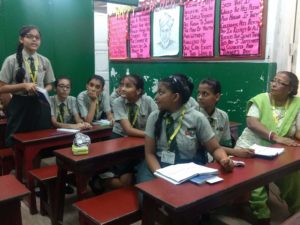Propaganda. The word stood out to us as Samya and I were going through the PeaceWorks Human Rights Defenders Programme module to prepare for our session at Chowringhee High School. Blatant right-wing propaganda has made its presence known widely in the political and cultural climes of India, particularly so in recent times. TV shows, films, newspapers and even advertisements make for potent vehicles of propaganda. Children are however, rarely taught what propaganda is or how it seeps into and affects their everyday lives. We decided to use this opportunity to generate discussion around propaganda using Anne Frank’s narrative as that of a victim of one of the largest propaganda-bolstered phases of mass violence in world history.
ccccWe began by asking them what they knew about the First World War and how it affected German citizens. Some responded with the dates, others mentioned terms like “Central powers” and “Allies”. Seeing that they were familiar with the basics, Samya asked them if they had learnt about the Treaty of Versailles in school. Yes, they had. Did they know that Hitler took advantage of the atmosphere of resentment that resulted from the conditions of the treaty to gain power? No, they said, they hadn’t quite made that connection.
ccccSamya explained to them that the treaty had led Germany into isolation from the rest of Europe. Germans felt that they had been given the short end of the deal- while other countries were able to flourish after the War, the German economy was suffering. He went on to the Weimar Republic and how it failed to solve Germany’s problems and encouraged the children to imagine themselves as German citizens in this situation–they didn’t have the social infrastructure they needed, they did not have enough financial opportunities and they could see that their country was falling behind the rest of Europe.
cccc‘How would you feel if you were one of them?’ I asked. ‘I would feel very jealous’, quipped one of the students. ‘I would think that this is very unfair and unjust’, said another. Linking this to Hitler’s use of popular sentiments to his advantage in order to rise to power, we discussed how he actively fed the people’s feeling of having been wronged, painting himself as their only available saviour to a glorious future.
ccccTo help the children understand how Hitler convinced people, we read from his autobiography Mein Kampf, where he discusses how propaganda should be used and how important a tool it can be to influence masses of people. Using Hitler’s writing, we talked about how political leaders use propaganda to promote their ideas and how most people are not even aware that they passively this.
ccccOn asking the children what types of media they consume on a regular basis, TV, internet, radio, newspapers and films were the most popular responses. We then shared how in Hitler’s Germany, most of the media the students mentioned, were the major instruments of Hitler’s anti-semitic propaganda. Had they ever thought of textbooks as books that were written with specific agendas in mind? No, they said. They had always been taught to regard what was written in a textbook as truth. They had never thought to question the intentions behind a textbook writer. We urged them to keep in mind that textbooks are extremely influential, which is why the Nazi party exerted tight control on the material in them.
ccccFinally, we read out sections from Anne’s diary where she had written about the effects this kind of propaganda had on her daily life. We encouraged them to imagine how they would feel if all the things we took for granted- our education, our recreational activities were suddenly forbidden–if we had to walk around with a sign denoting what community we belonged to, prompting people to treat us differently.
ccccBy the time we finished reading passages from Anne’s diary, the session was almost at an end. Before closing, we suggested they watch The Boy in the Striped Pajamas and promised to screen a film or a documentary in the next session. We also asked them to keep in mind that when we think of big tragedies like the Holocaust, we tend to reduce them to statistical terms- x number of people died, x number of people were injured and so on. However, we must remember that each of these millions of Jews was a unique individual with unique characteristics, dreams, ambitions, feelings and desires. We should try not to reduce them to numbers. Sharing the incident of the recent shooting at a synagogue in Pittsburgh, USA, we highlighted that anti-Semitism is not just a topic in the history book, but a contemporary one that continues to persist and needs to be opposed.
ccccAs in the first session, the children proved to be an attentive and interested audience, some taking down notes during our discussions, asking for spellings and clarifications. Some showed familiarity with the passages from Anne’s diary because they had begun to read it.
ccccSamya and I left feeling hopeful about this group of children at Chowringhee High School. They were keen to learn, willing to speak up, ask questions and were open to new ideas beyond their school curriculum. As the programme progresses, we hope to share and discuss these issues with them while we learn from them how they see the world and what they want to change about it.
Proiti Seal Acharya
Samyabrata Das

